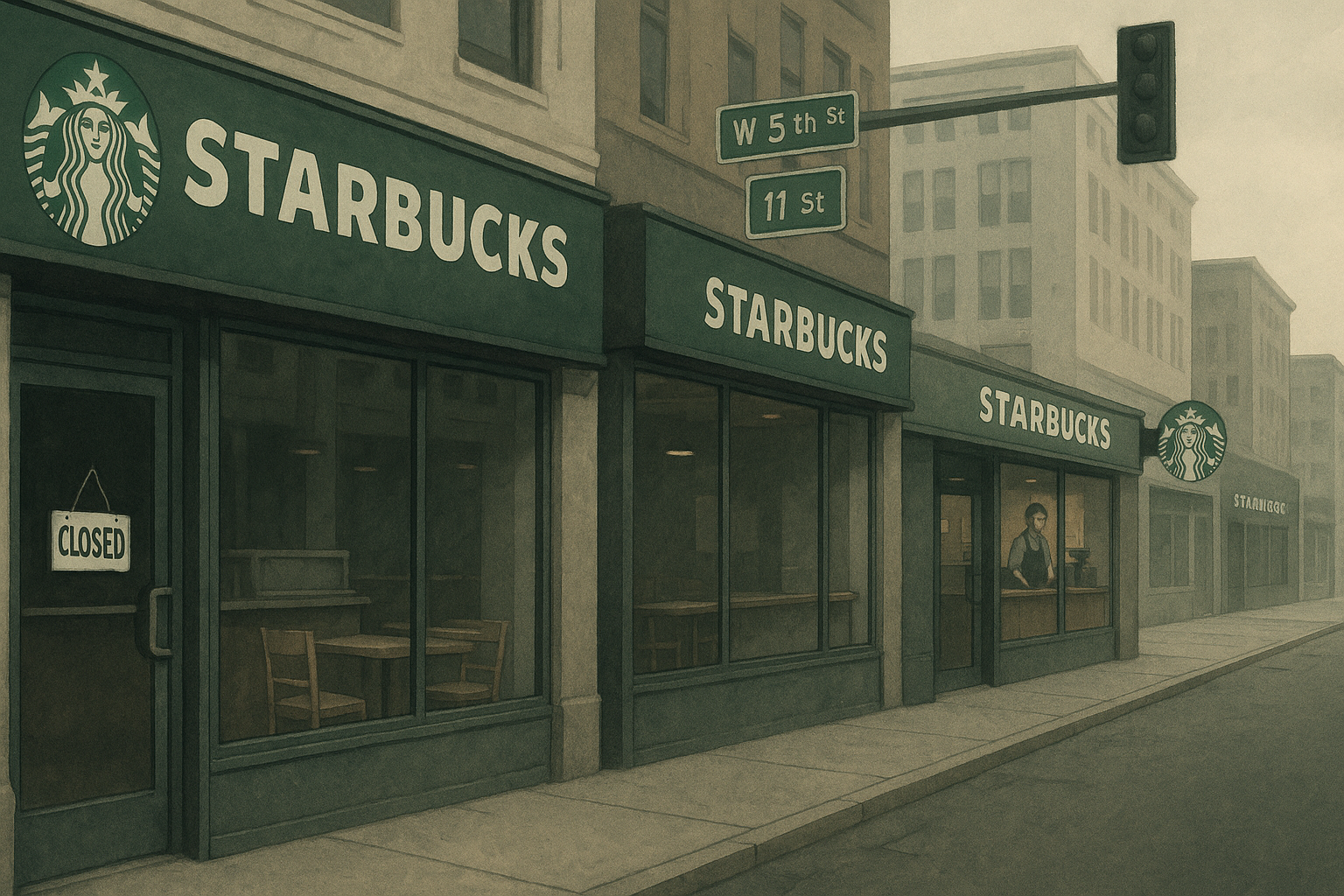Starbucks is finally admitting what many of us have muttered while walking past three green mermaid logos within a four-block radius: they've got too many damn stores.
The coffee behemoth has announced a massive $1 billion restructuring plan that includes store closures and layoffs. It's the corporate equivalent of a caffeine crash after a two-decade expansion binge that left the company more bloated than a customer who just downed a Venti Frappuccino with extra whip.
I've been tracking Starbucks' real estate strategy since 2018, and this move was practically inevitable. The writing's been on the chalkboard menu for years.
"We're taking decisive actions to position Starbucks for sustainable growth," CEO Laxman Narasimhan declared in the announcement, which is corporate-speak for "we screwed up and built too many stores too close together."
The Expansion Hangover
Look, this restructuring represents the predictable end of what business professors will someday teach as a classic case of overexpansion. Starbucks spent years following a growth-at-all-costs strategy that Wall Street absolutely loved... until they didn't.
Remember when you could make jokes about Starbucks locations facing each other across intersections? That wasn't hyperbole—it was their actual business model. (I once counted four locations visible from a single street corner in midtown Manhattan.)
The company that convinced Americans to regularly drop the equivalent of a fast food meal on coffee now faces the reality that, shockingly, not every street corner in America needs its own purveyor of pumpkin spice lattes.
Their expansion formula worked brilliantly—until it didn't. Each new store started cannibalizing sales from existing locations rather than capturing new customers. And yet, like so many retail chains before them, they seemed genuinely surprised when they hit this inevitable plateau.
WFH Killed the Coffee Star
The pandemic changed everything, didn't it? When office workers stopped commuting, they also stopped needing that $6 morning fix.
"The third place" concept—not home, not work, but somewhere comfortable in between—was Starbucks' entire identity. But in our new remote-work reality, that concept has become about as relevant as a CD player.
During a recent visit to a downtown Chicago location that used to have lines out the door, I counted just seven customers over a 45-minute period. The baristas looked bored. One was reorganizing the same pastry case for the third time.
When people can make coffee at home and don't have to rush to beat morning traffic, many have discovered they don't need to outsource their caffeine intake quite so frequently. Who could've predicted that? (Besides everyone.)
Cost-Cutting Won't Create Growth
Starbucks' restructuring playbook is straight from Corporate America 101: cut costs, close underperforming stores, lay off workers, then somehow promise this will lead to growth. It's like promising that cutting back on food will make you taller.
The $1 billion plan is part of what they're calling their "Reinvention" strategy—which, having covered corporate turnarounds for almost a decade, sounds suspiciously like every other corporate turnaround plan ever announced.
Just once I'd love to see a press release that honestly says, "We expanded too quickly because Wall Street demanded constant growth, and now we need to close the stores that aren't making money."
The cruel irony? Starbucks built its entire brand on premium positioning and customer experience. Now they're caught in that classic bind—how do you slash costs without destroying the very experience that justified those $7 lattes in the first place?
Union Busting or Coincidence?
This restructuring—and I find this timing fascinating—comes amid unprecedented unionization efforts, with workers at over 400 locations having voted to unionize since late 2021.
The company insists these moves aren't related to unionization. Uh-huh. And I'm sure it's just coincidence that many of the store closures will happen in heavily unionized areas.
Nothing says "we value our partners" (that's Starbucks-speak for employees) quite like announcing layoffs while fighting their organizing efforts. "We consider you family... which is why we're kicking some of you out of the house."
I spoke with three baristas at a unionized location in Seattle who expressed skepticism about the company's claims. One told me, "They call us partners but treat us like costs to be cut."
The Last Drop
What's happening at Starbucks reflects a broader reality check across retail. The company that once convinced us all that $5 coffee was a reasonable daily expense is discovering that perhaps their product isn't quite as recession-proof as they imagined.
In Seattle's Capitol Hill neighborhood—Starbucks territory if there ever was one—I've watched three independent coffee shops open in the past year, all packed with customers who used to frequent the nearby Starbucks.
The question now: will trimming locations and staff provide enough of a jolt to revive the coffee giant's prospects? Or is this just the first shot in a longer espresso of corporate contraction?
Either way, don't expect the price of your morning latte to drop anytime soon. That would be too much to ask from a company that's still trying to convince investors that the path to growth is through... serving fewer customers?
The grande-sized irony in all this? The company that taught America to overspend on coffee is finally learning something about financial restraint itself.
